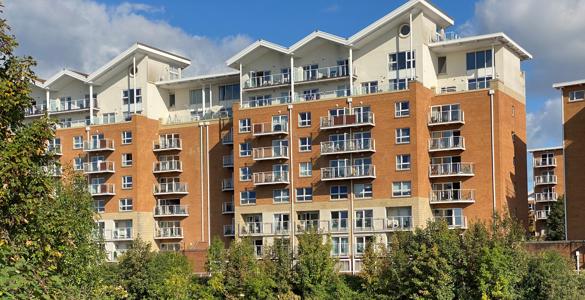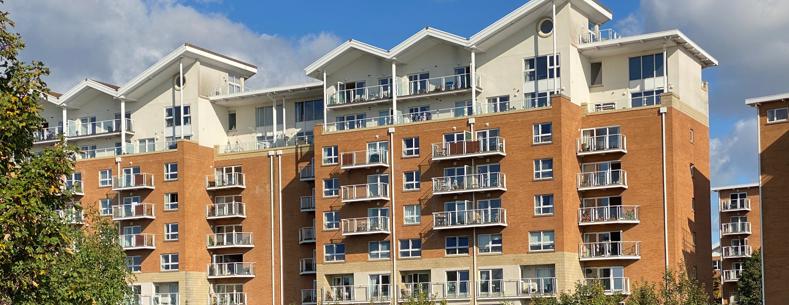It’s been more than eight years since the fire at Grenfell that killed 72 people. Today, there are still many hundreds of people in Wales living in buildings with unresolved safety issues, many of whom have suffered significant stress and financial losses.
The Welsh Government has a programme of work on building safety. The latest element of this is the Building Safety (Wales) Bill, currently at Stage 1 of the Senedd’s legislative process.
But this Bill is focused on the future safety regime for multi-occupied residential buildings. It doesn’t specifically seek to speed up the remediation of safety problems already identified in the wake of Grenfell.
Even so, the subject of remediation was a major theme when the Bill was discussed in Plenary on 8 July as well as in the Local Government and Housing Committee on 17 July.
This article takes a look at the progress of remediation in Wales.
Beyond cladding
The exact type of cladding used at Grenfell – Aluminium Composite Material, or ACM – has been removed from every building in Wales where it was found.
However, the Grenfell tragedy led to a fresh look at building safety across the UK that revealed far-reaching problems beyond cladding.
The Welsh Government set up the Building Safety Programme following a Programme for Government commitment in 2021 with an aim of identifying buildings in need of remediation.
It set itself the challenge not only of addressing exterior issues such as unsafe cladding, but also of solving safety issues inside buildings for all residential buildings 11 metres and taller.
In November 2023, the Welsh Government announced that all high-rise residential buildings had ‘a route to remediation’ in place.
This was partly achieved via a ‘developers’ pact’ between the Welsh Government and major developers such as Bellway, BarrattRedrow, Persimmon and Taylor Wimpey, underpinned by legally binding contracts.
By October 2022, 10 developers had signed the pact and by November 2024 the number was up to 12.
The Building Safety Programme’s most recent published figures, in its July 2025 building safety newsletter, show that by July, 461 buildings in Wales have been identified as having safety issues: 60% of these are in the private sector and 40% are in the social rented sector.
Of these 461 buildings, 43% have either had their safety works completed or have works underway.
However, the percentage is lower for the 161 buildings that are the responsibility of major developers.
The Welsh Government has recently changed the way it reports on developers’ progress. Unlike previous building safety newsletters, which used to report the numbers of buildings, the latest newsletter gives percentages for each developer.
Analysis of these percentages shows that works have begun or been completed on only 30% of developer-responsible buildings.
Works haven’t begun on the remaining 70%, although most (62%) have plans in place to begin in the future.
And in the whole of Wales, only four of these 161 buildings have seen their works completed.
Figure 1: Developer progress, July 2025

Source: Senedd Research analysis of data in Welsh Government building safety newsletter, July 2025
How does this compare with England?
The Welsh Government doesn’t encourage comparison between its own figures on building safety remediation and similar figures from England.
The Government’s position is that figures are not comparable since, unlike in England, the Welsh programme goes beyond unsafe cladding and is seeking to tackle both internal and external fire safety risks.
By contrast, the reform regime in England has focused only on life-critical fire safety risks on building exteriors.
Like the Welsh Government, the UK Government also has a pact with major developers to remediate safety issues in buildings that should be developers’ responsibility.
Data from the Ministry of Housing, Communities and Local Government states that as of the end of May 2025, 54 developers in England had signed a contract. There were 4,636 buildings covered by the contract, including 2,025 buildings identified as having life-critical fire safety risks.
Of those 2,025 buildings, 49% were reported to have either begun or completed remedial works at the end of May 2025, with 25% having completed works.
There are many outstanding problems in England, including some buildings still with ACM cladding, which has been removed from Welsh buildings – but unlike in Wales, there is a remediation acceleration plan.
Also unlike in Wales, there is a target date to remediate all unsafe cladding in buildings 18 metres or higher in England by the end of 2029, and for buildings 11 metres or higher to have completion dates in place.
These target dates are expected to be underpinned by a Remediation Bill which will impose a legal ‘duty to remediate’ on landlords, with unlimited fines or imprisonment for those who fail to complete remediation in time. The UK Government has announced that this Bill will be introduced ‘as soon as parliamentary time allows’.
While Wales doesn’t have a target date for completion, or criminal sanctions for failure to comply, the Welsh Government has taken steps to urge developers to begin works.
In November 2024, the Cabinet Secretary set developers a six-month target to assess and plan remediation works on all buildings they are responsible for in Wales.
Earlier this month she reported to the Senedd that all developers have agreed to ‘have at least started’ works on all their developments in Wales by the end of 2026.
Scrutiny in the Senedd
When the Cabinet Secretary gave an update in Plenary on 8 July, several Members questioned her about developers’ apparent slow progress in addressing safety concerns in buildings such as Altamar in Swansea and Victoria Dock in Caernarfon.
The Local Government and Housing Committee has also been questioning the Welsh Government on developers’ progress.
Following a meeting with the Cladiators campaign group, in March 2025 the Committee wrote to the Cabinet Secretary to express concerns and ask for clarification on the figures.
The Cabinet Secretary responded in April, stating that there had been no breach of the contract terms between developers and the Welsh Government.
The Cabinet Secretary’s letter mistakenly reported a higher figure for the proportion of buildings where developers’ works were underway or complete. The Committee pointed this out, and the Cabinet Secretary responded with an apology and some fresh figures, which largely reflect those in the Welsh Government’s latest building safety newsletter.
The Cabinet Secretary then gave evidence on the Bill to the Local Government and Housing Committee on 17 July.
Under questioning about developers’ progress, the Cabinet Secretary admitted that the deadline of end 2026 for beginning works is not legally binding. But her official said that the Welsh Government does have the ability to take legal action against developers, ‘if it comes to that’.
The Cabinet Secretary said that she was ‘keen to see that pace in the system’, but the complexity of some works is holding things up.
The Bill’s next steps
The Committee will be hearing more evidence during the autumn term and will produce its Stage 1 report on the general principles of the Bill by 28 November 2025.
Given Members’ continued interest in the progress of remediation within their constituencies, the issue of developers’ progress is likely to keep raising its head.
Some key questions remain, including:
- whether Wales needs a remediation acceleration programme;
- whether there needs to be a target date for completion; and
- whether there need to be stronger legal sanctions, like those planned in England, to force developers to pick up the pace.
Article by Jennie Bibbings, Senedd Research, Welsh Parliament






